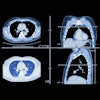Sunday, November 29 | 10:45 a.m.-10:55 a.m. | SSA04-01 | Room S404CD
Chronic obstructive pulmonary disease (COPD) is a well-known risk factor for lung cancer. But do some COPD phenotypes carry a greater risk of malignancy?"The finding of a lung nodule on a low-dose CT performed for lung cancer screening often prompts further investigation and generates anxiety for the patient," wrote Dr. Caroline Chiles from Wake Forest University Health Sciences Center. "The likelihood that a nodule is malignant can be assessed with a risk prediction model."
In a study of 6- to 9-mm indeterminate lung nodules, readers performed a visual analysis of CT scans for centrilobular emphysema, bronchial wall thickening, centrilobular nodularity, and interstitial fibrosis. They were asked to classify each scan as normal, emphysema-predominant COPD, airway-predominant COPD, or mixed-pattern COPD.
"We found that CT evidence of centrilobular emphysema, paraseptal emphysema, and the CT-defined emphysema-predominant COPD subtype were more closely associated with lung cancer risk than spirometric evidence of airflow limitation," Chiles told AuntMinnie.com.
CT information for both the emphysema-predominant COPD phenotype and severity may perform better in risk prediction than spirometry, the authors concluded.




















